Our Facebook Page to Follow: Aquarium/Pond Answers Facebook
This is a unique resource for answers, help, & advice to aquarium and pond questions not found elsewhere; With regular posts & article updates.
In our research; we use aquaculture, horticulture, medical, & university research to compile many of our articles.Our Recommended Lighting for highest efficiency professional planted/reef aquariums: "AquaRay Lighting"
Plaster of Paris, Gypsum, or Tums; Use in Aquariums, Ponds
By Carl Strohmeyer-PAMR 40+ years experience
Updated 1/22/19
THE DIFFERENCE BETWEEN PLASTER OF PARIS AND PRODUCTS SUCH AS WONDER SHELLS OR SEALAB
I have read in many places about the use of Plaster of Paris (& occasional Tums too??) as a mineral source for both ponds and freshwater aquariums.
I too have used this many years back when old timers in the hobby suggested its use for ponds to me, however with the exception of a calcium emergency or possibly to absorb pollutants in a pond in bulk, which I have used Plaster of Paris for; Plaster of Paris is not the same as Wonder Shells, SeaChem Replenish, Sealab blocks, or similar products designed for aquarium use to add major and minor elements required by ALL fish, both fresh & saltwater.
Product Resources:
*Wonder Shells (Best Method as it adds mineral Cations constantly and is more complete)
*SeaChem Replenish
My own years of use have shown me the vast difference in fish health and vitality.
In this article I will hopefully explain this a little more scientifically.
ADVERTISEMENT
PLASTER OF PARIS:

Plaster of Paris is manufactured by heating gypsum at 120 - 160 C. When Plaster of Paris is mixed in water it dehydrates and forms dense matrix of gypsum crystal.
Here is a list of ingredients of Plaster of Paris:
- CaSO4, 1/2H2O: 97.97%
- SiO: 0.94%
- Al2O3: 0.69%
- Fe2O3: 0.28%
- MgO : 00.12%
What I see here is some Magnesium Oxide, Iron, Sulfur, Aluminum, Silica and mostly Calcium Sulfate.
Where is the Strontium, the Sodium, Potassium and more?
These ratios are also NO WHERE near correct for proper assimilation.
This is not to say that products such as Wonder Shells or Kalkwasser are also spot on in these ratios, however they are much closer than this.
This is also why Marine Buffer by SeaChem is better for KH control as the proper ratios are applied in this product.
It is also noteworthy that Calcium Sulfate (Gypsum) is not the best source for Calcium in a “living” aquarium environment.
Calcium Hydroxide (Kalkwasser), Calcium Carbonate, or Calcium Gluconate (the calcium salt of gluconic acid, an oxidation product of glucose) are MUCH better sources for calcium in a LIVING aquatic environment.
In plant and animal studies, calcium chloride and calcium sulfate (found in Plaster of Paris), have been known to cause problems, however the problem is generally associated with the anions Cl- or S04 rather than calcium which is a necessary nutrient for plant and animal life and even in high amounts is safe by itself or in the other forms I recommended earlier in the paragraph.
Calcium sulfate is also a poor source of ESSENTIAL positive mineral ions (cations), this may be in part due to the -SO4 anions present in CaSO4 (Calcium Sulfate). This is an important difference since the aquatic environment already produces many Anions, we need Cations to balance this out or fish health will eventually suffer!!
Reference: Aquarium Redox
Calcium Sulfate (Gypsum) also does not react with acids which is important in our aquatic environment for maintaining a healthy balance of Redox, as well as generating CO2 for plants.
There is also a lot of mis-understanding in the aquarium community as to how VERY important bio-available calcium is, again Calcium Hydroxide, Calcium Carbonate, Calcium Gluconate; NOT Calcium Sulfate found in Plaster of Paris.
Calcium is a very important mineral/electrolyte for so many body functions such as muscle contraction which is initiated by a sudden increase in calcium concentration in the muscle cells.
Calcium is also important in times of stress, which is why a new fish added to aquarium that has poor bio available calcium is very likely to get sick and often the aquarist blames the opportunistic disease rather than realizing that the fish may be suffering form the lack of electrolytes such as calcium.
Another ingredient found in Plaster of Paris is Silica; this mineral can cause algae problems (especially brown) and is especially troublesome in marine aquariums.
Plaster of Paris is also a poor choice for GH or Calcium as Calcium needs to be in the proper ratios with other elements such as Magnesium to be utilized by aquatic life (such as osmotic function).
PROPER OCEAN CHEMICAL ANALYSIS:
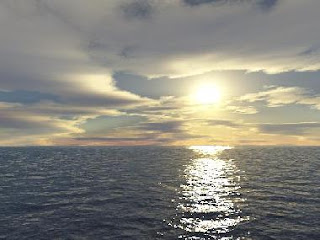
By contrast here is the chemical composition of the ocean as a percentage:
- Chloride- 55.03%
- Sodium- 30.59%
- Sulfate- 7.68%
- Magnesium- 3.68%
- Calcium- 1.18%
- Potassium- 1.11%
- Bicarbonate- 0.42%
- Bromide- 0.19%
- Borate- 0.08%
- Strontium- 0.04%
- Fluoride- 0.003%
- Other- less than 0.001%
It is important that we try and achieve at least some balance when adding minerals back into our aquariums. This ocean water composition is easily extrapolted over to freshwater with simply lower numbers and of course much less sodium & chloride.
When you add products not intended for mineralization of water containing fish or other aquatic life such as plaster of paris or Tums, you are simply screwing with your long term aquarium chemistry and aquarium health.
For more about Calcium, Electrolytes in aquariums, please read this article:

CALCIUM, KH, AND MAGNESIUM IN AQUARIUMS
TUMS IN AN AQUARIUM
Although I have not used Tums in an Aquarium (although friends in the industry have tested Tums with poor long term results), I know enough about aquarium chemistry to know that the calcium carbonate that makes up this product are NOT a complete/balanced mineral source. For all the essential positive mineral ions fish require, and despite some forums that recommend the use, it is quite obvious from reading material already cited earlier in this article that Tums should not be used either.
The result is a lack of balance in aquarium chemistry (such as magnesium).
As well, Tums have other added ingredients to add flavor, maintain freshness, add color, etc that have no business in your aquarium.
RELATIONSHIP BETWEEN OCEAN WATER AND INTERNAL CHEMISTY OF ANIMALS:
I brought up ocean water chemical analysis to make a point that is the plasma and internal chemistry of all animals and fish are similar in composition to the ocean. This is why many electrolytes (elements) are important in the chemistry of aquarium environment including fish food.
Rene Quinton is a scientist who died in 1925.
"He postulated that from the mineral point of view, human and marine plasmas are environments of the same nature. In other words, there is physical and physiological identity between seawater and the internal environment of the organism.
Not only do they exhibit very similar mineral compositions, but the particular form, organization and synergy of trace elements and mineral salts that make up the saline matrix of seawater closely resemble those of the internal environment constituents."
Reference:
www.oceanplasma.org/
For more about proper Osmotic Function in fish, pleas see this article:
PROPER OSMOTIC FUNCTION
SUMMARY;
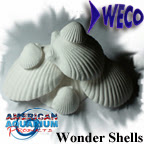
Basically my point is that all you add to your aquarium (freshwater or saltwater) should emulate this ocean ratio as close as possible. In saltwater, fish are constantly drinking the water around them for proper hydration and osmotic function so they are very sensitive to their water chemistry.
In freshwater the fish are absorbing the water around them for hydration and osmotic function so they are less sensitive to poor water chemistry, this said, that is why you can often get away with dumping Plaster of Paris in freshwater Aquariums or ponds.
This in NO way means you are providing the proper electrolytes your fish need. Using products such as Sea Chem Buffer, SeaChem Replenish, or Wonder Shells are more likely to achieve a better balance here.
Besides, why would you want to throw a product in your aquarium manufactured by heating gypsum?
References:
*Wonder Shells (Best Method as it adds mineral Cations constantly and is more complete)
SeaChem Buffers
SeaChem Replenish
Other Recommended Reference/Product Sites

Aquarium Information and Resources (Pond too)
*
Aquarium & Pond UV Sterilization; Facts & Information
*For TRUE low pressure, hot cathode Germicidal UV Replacement Bulbs:
UV Bulbs; For Aquarium, Pond, Purifier

Complete Pond Care
*
Aquarium (or Pond) Nitrogen Cycle
*For a friendly, Knowledgeable, aquarium forum with in a family atmosphere:
Aquarium Forum; Everything Aquatic

Spirulina 20 Fish Food Flake
The best balanced fish flake food diet for Tetras and other fish for disease prevention/p>
TMC V2 RO Filter systems; the very best you can buy with TDS meter (far superior to 4 stage RO/DI systems sold via Bulk Reef Supply, Amazon, or eBay that use the inferior cellulose triacetate membrane made by Dow):
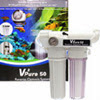 Reverse Osmosis Aquarium Water Filters; with TDS Meter
Reverse Osmosis Aquarium Water Filters; with TDS Meter
*Parasite Retailers, Pet Mountain, Amazon
The best in Quartz, Under gravel, and Titanium Submersible Heaters:
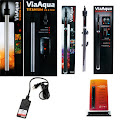
Aquarium Heaters
ADVERTISEMENT
Labels: Aquarium GH, Aquarium Minerals, Boby Fish, Fish GH, Gypsum, Gypsum aquarium, Plaster and Fish, Plaster of Paris, Pond Minerals, Tums Aquarium
Neon Tetra & FNT Disease; Sporozoan Fish Infection
NEON TETRA DISEASE (Identification, prevention and possible treatment of):
Also the similar infection; FNT Disease (False Neon Tetra Disease)
(Scroll further into the article for FNT)
By Carl Strohmeyer-PAMR 40+ years experience
Updated 11/25/24

This term is often a catch all name for diseases of Neon Tetras specifically and many other fish as well, especially other Tetras.
The usual cause is by a Sporozoan (parasitic spore-forming protozoan which reproduce sexually and asexually in alternate generations by means of spores); Pleistophora hyphessobryconis, although there are other causes including many fungi that will imitate this Sporozoan infection.
The true Pleistophora hyphessobryconis infestation is very difficult to treat, and basically impossible to treat in the later stages of this infestation, which is when most aquarists first notice this disease.
However, contrary to popular opinion on the web and elsewhere where many are just repeating what they hear/read elsewhere it is SOMEWHAT treatable in the early stages and VERY preventable from spreading based on my long time professional experience and experimentation.
Occasionally rare gram positive bacteria will also cause these symptoms (fading, loss of color, etc.) which require a different course of action.
ABOUT THIS INFECTION:
The disease cycle begins when parasitic spores enter the fish after the fish ingests infected food or organic debris, such as the bodies of dead fish, or live food (often Tubiflex Worms).
After the spores enter the intestinal tract, the newly hatched embryos burrow through the intestinal wall and produce cysts within the muscle tissue. These muscles containing the cysts begin to die, resulting in a pale whitish tissue.
Initially the only symptom may be restlessness especially when lights are turned on and off.
The infected fish often will stop schooling with others of their species. Soon the swimming becomes more erratic and the tell tale symptom of the white muscle tissue becomes apparent.
Other fish are susceptible to this infestation as well, this includes and is not limited too:
*Most Tetras
*Many Danios (including White Clouds)
*Angelfish & other Cichlids
Symptoms in order of progression:
- Restlessness and sensitivity.
- The fish become more isolated
- The fish has difficulty swimming (at this point treatment will generally fail)
- The tell tale white/ pale tissue appears.
- As cysts develop and produce more spores, body may become lumpy or irregular.
- Often in advanced cases spine may become deformed or curved.
ADVERTISEMENT
Before any aquarium/pond fish treatment it is important to know all the steps as often treatment is much more than dumping medication into an aquarium.
Please read this article before ANY aquarium treatment regimen:
Fish Diseases | How to Treat Sick Fish
TREATMENT (and more importantly; stopping the spread of this disease):
Removal of ALL infected fish from main aquarium if at all possible (along with the use of true UV Sterilization in the main aquarium).
A "bath" with Methylene Blue is the first step.
To prepare this bath I use 1-2 teaspoon 2.303% solution per 5 gallons in a bath of aquarium water from the tank the fish you wish to treat came from, I usually use about a ½ gallon of water, however you may use less. With Kordon's Methylene Blue, 10-20 drops per gallon will work.
Measurement of the Methylene Blue does not need to be too precise as this bath should only be used for about 30 minutes and Methylene Blue is safely overdosed for fish in baths, dips, or bare hospital tank. However overdosing in established aquariums can kill beneficial nitrifying bacteria.
This bath’s effectiveness is improved further by the addition of salt (at 1 teaspoon per gallon) AND Metronidazole at double the normal "in-tank" dose recommended by the manufacturer.
A Medicated Bath Resource:
How to Perform a Medicated Bath
Recommended Product Resources:
*AAP MethyBlu (Premium Methylene Blue formulation)
*AAP/SeaChem Metronidazole (Metroplex)
Make sure you keep the water in a warm area, as in a cold room the water temperature can drop rapidly which would stress the fish.
Do NOT pour this water back into your display aquarium when finished.
This bath can be performed twice per day.
Adding Nitrofurazone to this bath at double recommended tank dose instead of Methylene Blue can improve results.
Erythromycin can be substituted, especially for FNT Disease (Erythromycin Phosphate as found in AAP Mycin is more effective than the Erythromycin Sulfate found in API Erythromycin or Mardel Maracyn).
This bath is helpful for the both “True Neon Tetra Disease” and false neon tetra disease (FNT Disease).
In tank; I suggest the use of Naladixic Acid for just one dose, followed in 24 hours by a water change. If not all fish are affected, I suggest a hospital tank for this, although often Neon Tetra Disease picks off fish one by one some display aquarium treatment becomes necessary.
If Naladixic Acid (Naladin) is not available, AAP Nitrofuracin Green can be used, and in difficult cases, at 1.5 times the normal dose.
Product Resource: AAP Naladin; Naladixic Acid
Alternative "in tank" treatments (but less effective than Naladixic acid) includes ParaGuard-Parasite or Super Ich Plus (Super Ich is stronger than ParaGuard) combined with either Nitrofurazone (AAP Furacyn or less effective Furan 2) or Metronidazole.
Another alternative is the use of AAP Myacin in the main aquarium, although this is more effective for FNT Disease (discussed later), or simply for unknown Tetra "die offs".
Medicated Wonder Shells are excellent as a follow up treatment or for mild infections.
Continue this treatment for 7-10 days.
Recommended Product References:
*AAP Myacin (SUPERIOR Erythromycin Phosphate)
*API Erythromycin
*AAP ParaGuard-Parasite Treatment
*AAP Super Ich Plus
*AAP Furan 2
* For a good follow up treatment either after fish have mostly recovered or as a preventative:
AAP Medicated Wonder Shells
 For very mild cases, an alternative to a bath would be the external application of Mebromin to the tetra (make sure both sides of the fish are applied to).
For very mild cases, an alternative to a bath would be the external application of Mebromin to the tetra (make sure both sides of the fish are applied to).
Product Resource: AAP Wound Control (Mebromin)
If at all possible I strongly recommend attaching a UV Sterilizer after treatment or removal of sick (or dead) fish.
This device will help in the spread of disease and improve Aquarium Redox (which improves immunity).
For more information about UV Sterilization. Please read this VERY IN DEPTH & RESEARCHED article:

ULTRAVIOLET STERILIZATION; How UV Sterilizers Work.
This article explains the benefits and myths about TRUE aquarium and pond UV sterilization as opposed to the many UV Clarifiers sold via Amazon & eBay masquerading as true UV Sterilizers (most of these are only meant for water Clarification).
It is also essential for UV Sterilizer to remain effective for prevention and Redox aid, that you change your UV Bulb every six months (regardless of some claims by less than honest long life, yet low output UV Bulb sellers)
Redox Reference: Aquarium Redox
Recommended Product References:
*High Output Hot Cathode UV Bulbs
*UV Sterilizers
A medication containing Metronidazole or an additional treatment of Metronidazole in tank can be very helpful as well.
Note: this is infestation is difficult to treat and takes a "medication cocktail" approach to defeat.
In the even more rare cases of FNT disease Erythromycin may be effective (I still recommend the medicated Methylene Blue bath). See False Neon Tetra Disease (FNT) section of this article below.
Medication Information Resources:
Aquarium Medications; How Metronidazole Works
Aquarium Medications; How Erythromycin Works
PREVENTION & ANECDOTAL IDENTIFICATION
It is noteworthy, based on my “house calls”, emails, customers, etc, in my years of Aquarium Maintenance & answering questions online, that the majority of Tetra Disease diagnosis are incorrect. Sadly this disease is often misdiagnosed.
Here are (in order of most common) miss-diagnosis causes of Neon Tetra Disease:
- Ammonia or Nitrite Poisoning
Reference:
https://www.americanaquariumproducts.com/Nitrogen_Cycle.html - Poor fish stock that was recently purchased, often suffering from the residual effects of Ammonia poisoning due to poor shipping/handling methods or simply genetic in-bred Neon Tetras (or other fish)
- Miss-diagnosis for the fish disease Columnaris.
Reference:
Columnaris in Fish; Treatment/Prevention - Long term poor aquarium health maintenance procedures, this includes regular water changes & vacuuming, aquarium chemistry methods, and much more.
Even proper aquarium lighting plays a minor role in fish health (as with most other animals and plant life).
Reference:
Aquarium Disease Prevention
Here are a few important steps summarized to prevent both Neon Tetra & FNT Disease:
- Maintenance of optimum water chemistry.
This includes low to zero ammonia/nitrites, a stable pH (and not too low of a pH, as pH numbers under 6.5 are favorable to NTD), a balanced Redox (which includes not only high oxygen levels but important reducers to lower oxidative stress), and a constant supply of mineral Cations. - Quarantine or at least use of fish baths for all new stock.
- Removal of ALL infected fish from your main stock along with true level 1 or 2 Sterilization with a HO UVC lamp in your main aquarium/tank (this does not mean a UV Clarifier such as a Green Killing Machine).
- Following most if not all steps outlined in the disease prevention article I provided earlier (which includes these previously mentioned steps).
Reference:
Aquarium Disease Prevention - Basically locating a good source (& sticking with it) for your Tetras and other fish that are easily infected by Neon Tetra Disease (& FNT disease) and following all or at least most of the procedures outlined in the article; “Aquarium Disease Prevention”, this disease should actually quite rare.
In fact I have not nor have our sister Aquarium Maintenance company’s regular full service clients had a case of this disease in quite some time (years as of this update).
Most cases were diagnosed with “occasional” service customers or online/forum questions.
Recommended Aquarium Maintenance Companies
FNT DISEASE:
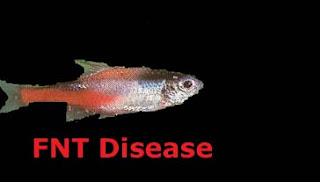
I will note it is common to confuse true Neon Tetra Disease caused by the Sporozoan; Pleistophora hyphessobryconis with other diseases such as many fungi infections and often gram positive bacterium, this is called False Neon Tetra Disease or FNT Disease and is generally caused by less common gram positive pathogens.
These false infections often do not have the symptoms leading up to the white/ pale tissue and the discoloration is more faint and much less white and defined than True Neon Tetra Disease.
As with True Neon Tetra Disease caused by Sporozoans, treatment is very difficult (but not impossible) while prevention is much easier. Often the best treatment is removal and euthanasia of affected fish then following preventative measure outlined earlier.
For treatment that has any potential of possibly working, a medicated bath is an important first step.
However in tank (or better hospital tank) treatment should also consist of a primarily gram positive “cocktail” such as Erythromycin (preferably Erythromycin Phosphate, not the much less effective Erythromycin Sulfate found in the API product), possibly adding either Medicated Wonder Shells, AAP Super Velvet, or maybe Kanamycin.
AAP PolyGuard is another possible treatment based on ingredients (although I have not used it for FNT Disease).
The use of a diatom filter before in tank treatment (not during) may help, but I have had very mixed results with this extra step, so I cannot confirm this steps make much difference in an already difficult to treat disease.
Please note that these combinations (that all start with Erythromycin) are EXTREMELY hard on bio filter bacteria, so use in a quarantine/hospital tank is strongly recommended.
As lesser strength "in-tank" treatment, but less harmful to bio filtration would be Kordon Herbal Ich (& Fungus) Attack
As a side note, I have observed FNT disease (not True Neon Tetra Disease) when many cycling aid products have been used, and since many use aerobic/gram positive Heterotrophic bacteria (possibly Actinomycetes), there may be a relation.
This is only an observation, but I have noted this on several occasions with many Tetras (as well as few Danios/Rasboras), so I would cease the use of these products if FNT Disease is suspected. I should note that I have not observed this with the better Cycling aids such as Fritz, SeaChem Stability, or my preferred cycling aid; "AAP Bacter Plus".
Further Product References:
*AAP Myacin (SUPERIOR Erythromycin Phosphate) (this product is a much better choice over the lessor Erythromycin Sulfate found in API Erythromycin or Mardel Maracyn)
*Kordon Herbal Ich (& Fungus) Attack
*AAP Super Velvet Plus (also for Fungus)
*SeaChem Kanamycin from AAP
*SeaChem PolyGuard from AAP
*To aid in nitrifying bacterial replenishment after treatment:
Effective Stabilized Natural Bacteria; Stability
Summary
If all these steps are followed my success rate in stopping the spread of these diseases is nearly 100% and treating early stages at around 20% for Neon Tetra Disease and 40-50% for FNT Disease.
If you cannot add the UV Sterilizer, the other steps will still help a lot, especially in stopping the spread.
But if you can afford a UV Sterilizer, purchase one, and not a UV Clarifier sold at Amazon, PetCo and others such as the Submariner or Green Killing Machine, rather a TRUE LEVEL ONE Sterilizer such as the TMC Vecton, AAP Terminator or CUP series (with prefilter)!
Water Changes are also important with both Neon Tetra Disease & FNT Disease immediately prior to each treatment. The use of the professional aquarium water conditioner AAP Res-Q is highly advised with each water change (even over other good water conditioners such as SeaChem Prime which is still inferior, especially when treating fish for disease).
Resource: AAP Res-Q
This is why this “treatment cocktail” is often required and following ALL STEPS IS A MUST.
Further Reference:
Mycotic Diseases of Fish
Other Recommended Reference & Product Sites
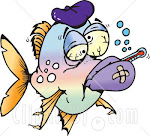
Fish Diseases | How to Treat Sick Fish
*UV Sterilizer Reviews: Equipment to AVOID
*TMC Vecton and Advantage Premium High Dwell Time UV Sterilizers
*AAP CUP Series Submersible True UV Sterilizers
*
Aquarium Lighting
The most in depth aquarium lighting article, an important read even for basic fish keepers!
*Fish Nutrition
*Aquarium Ich
*Pond Care Information

TMC Premium Fluidized Sand Bed Filters
Premium, second to NONE Aquarium Bio Filters, that with optional Oolitic Sand also maintain essential marine aquarium calcium levels, alkalinity, & electrolytes that are important to ALL Marine life, Goldfish, African Cichlids, Livebearers & more

AAP Custom Super Premium by Fish Food Guru Clay Neighbors
There is simply NO better prepared fish food; NOT Repashy, New Life Spectrum, or NorthFin, etc.
Best energy levels, best fiber content, best protein optimization, no added supplements.

Spirulina 20 Fish Food Flake
The best balanced fish flake food diet for Tetras and other fish for disease prevention
ADVERTISEMENT
Labels: Faded Neon Tetra, false neon tetra disease, FNT Disease, Neon Tetra, NTD, Pleistophora hyphessobryconis, Sick Tetra, Sporozoan Infection
AQUARIUM & POND TEST KITS; Review, Use, Directions, Information
AQUARIUM TEST KITS; what they are used for and their importance.
By Carl Strohmeyer
Updated 5/13/20
This article is divided into Overview, Freshwater Tests, & Saltwater Tests.
Many Tests that are duplicated in saltwater are only given a broad description in the freshwater section.
| *Ammonia | GH & KH | pH |
| Nitrates | Nitrites | Iron |
| Phosphates | CO2 Test | Multi Test Strips |
| Redox Meter | Dissolved Oxygen | Marine Magnesium or Calcium |
| Iodine | Silicate | Hydrometers/Refractometers |
Overview
What is especially noteworthy as per my decades of taking care of literally 1000s of aquariums, many one aquarium right after another, where by fast, economical, and reasonably accurate tests were important in the end is all it really came down to as to what is needed to "get the job done". It is also noteworthy that my time was worth more than the savings a liquid test kit might save, especially when it came down to titration tests.
I constantly read online or get questions from aquarium keepers about the so called lack of accuracy of test strips or common liquid test kits such as the API line (I by no means am a supporter of all things API, especially with their pushing of the terribly incomplete so-called "Master Test Kit").
All we are looking for in general aquarium keeping husbandry is trends and reasonable ball park figures, not 10ths of a degree accuracy needed for some scientific experiment (IMPORTANT NOTE, we are not working on a cure for cancer here, just getting basic generalized numbers of our aquarium water parameters).
As per the "API Master Test Kit", out of principle, I have ceased selling this kit decades ago as while it is certainly an economical test kit per each test performed, this kit unfortunately gives newbies a false since of security that it is a complete test kit.
I get emails and forum questions weekly where an aquarium keeper is surprised that this kit is not complete. In a recent example, an email asking for help with pH crashes could not figure out why and once they finally got a GH/KH tester, the answer became obvious.
Often, as with those who improperly use a medication (such as wrong parameters, incorrect dose, etc.), many will have one or two "bad experiences" and label a test kit/strip as inaccurate (and often these bad experience has more to do with human error than the tester itself).
HOWEVER in my 1000s of daily tests, I have to throw out the very rare anomaly and state I have found little difference in most basic test kits as per what the job requires (I also performed many controlled tests of test kits & strips).
IN FACT, most "bad" readings of test strips in particular were still traceable to user error on my part such as sticking a wet finger in the strip container in previous tests, failing to place a desiccant in the strip container after initial opening, or not holding the strip flat after dipping, thus allowing mixing of water between test squares.
When used properly, 1000s of accurate readings over a few decades of professional use DO NOT LIE!
With liquid test kits, not properly rinsing test vials (RO water is best) was a common human error.
Even when a reading is not 100% accurate, does a KH reading of 160 ppm versus 140 ppm make that much difference as long as it is showing trends such as a decreasing KH (possibly indicating an ever increasing bio load which would likely then call for lowering the bio loads and/or increasing water changes and increasing alkaline buffers)??
The exception would be for measuring rH (Relative Hydrogen) where a highly accurate ORP and pH reading are needed to complete this formulation.
Reference: Aquarium Redox; Measuring rH
In the end, I found NO DIFFERENCE in aquarium keeping outcome between highly accurate but often more difficult to use and more expensive per use test kits. But if you have lots of time and enjoy spending more money than you need to, by all means purchase these more pricey test kits.
It is always best to have as many different test kits as you can afford (as they apply to either freshwater or saltwater.
I prefer to purchase my test kits separately as most master test kits duplicate tests I do not use regularly and leave out essential ones I (& others) need for established aquarium such as important KH and GH tests, or possibly Phosphate, Calcium, or Redox.
The "AAP/API 5 in 1 Test Strips" (and similar by Mardel & Tetra) often have the tests that I generally use for my established tanks in a very convenient form that are accurate enough for regular monitoring (then stepping up to a liquid or a test meter if something is off).
I find these vastly more useful and time efficient than so-called Master Test Kits which exclude the very important GH, and KH tests (without a KH test one cannot correctly maintain a steady pH or track bio load and without a GH one cannot monitor essential minerals).
The only missing test in the "5 in 1 strips" is for ammonia, however the nitrite test is often all one needs for an established aquarium.
For my newer client's aquarium or simply quick reference in my established aquariums, I prefer a SeaChem Ammonia Alert as this is an easy to notice warning test that is always present in the aquarium. More importantly this test kit test ONLY the toxic NH3, NOT the non toxic NH4 ammonium combined with NH4 most other ammonia test kits cannot differentiate between.
See these product links:
*AAP/API 5 in 1 Test Strips; pH, Nitrite, Nitrate, General Hardness and Carbonate Hardness
*AAP/SeaChem Ammonia Alert; free ammonia NH3 test
Another important point to testing your aquarium is that it is always useful to know what your tap water parameters are for comparison to aquarium water, this way you can make educated decisions as to water changes or problems with parameters such as pH. Often
It is noteworthy that tap water (including well water) needs to “gas out” before testing for pH as trapped CO2 will often give false readings of a lower pH until all the CO2 evacuates the water sample (I have seen more than .5 pH changes in gassing out).
Please reference this article for more information about pH: “Aquarium Chemistry; pH”
Many other aspects of water measurement can be high in tap water. Phosphates are another example where by I have seen and heard of readings as high as 5-10 ppm (it is noteworthy that some water conditioners such as Novaqua can add phosphates). So chasing phosphates numbers in an aquarium starts with knowing your tap water readings and other additives you might add to the aquarium.
Further Reading:
Aquarium Water Conditioners; Novaqua
Use of RO water in Aquariums to improve new water quality
In marine aquariums it is also important to know what your pre-mixed water alkalinity, pH, and nitrates are as well as the water you use to top off for evaporation.
Finally, before I go into each test kit explanation/review. I should note that any liquid based test that involves a vial, should have the vial carefully rinsed with DI water (Distilled/De-ionized) before each new test, otherwise the next test will be possibly compromised.
Tap or well water still has some nitrates, minerals, carbonates, etc. so use of this water for cleaning should be avoided.
Please note that while readers will note that API tests are most predominantly used as examples, this does not mean I am recommending these as the best kits.
My extensive use of API and other test kits over the last 4 decades of my professional aquarium keeping career has shown these to be a good value, with accuracy that is "good enough" for 95% of aquariums maintained (it is noteworthy we are mostly looking for trends, there is rarely a need for a university level study accuracy test).
Readers should also note that I also recommend many others kits where in particular they fill a niche that API does not such as SeaChem's Ammonia Alert or Ista's CO2 test.
Freshwater Test Kit Video

Freshwater Test Kits- Liquid and Strips
ADVERTISEMENT
Here is a list of FRESHWATER Test Kits, followed by Saltwater Test kits (many tests overlap, so I do not give a full explanation in both sections, often I will give the full explanation in the freshwater section).
[1] Ammonia Test Kit; There are two common Ammonia test kits used most often by aquarists.
The Salicylate test kits that read the lower range needed for aquarium keeping between 0-1.0 ppm. The other common ammonia test Kit is the Nessler test, which reads in shades of yellow or amber for all its readings and tests in the high range of 3-10 ppm.
The Salicylate test reads in shades of yellow to green to blue-green, and is much easier to read than the Nessler test and more appropriate for aquarium fish and sensitive invertebrates since it is more accurate at lower ppm.
The API Ammonia Test Kit is a popular liquid Salicylate based ammonia test kit.
Product Link: API Ammonia Test Kit
 Another type of test kit is the SeaChem Multi Test Ammonia or the SeaChem Ammonia Alert which uses a gas exchange sensor system which is not affected by the presence of Prime, Amquel Plus, AmmoLock, etc., or other similar products. It also has the added advantage that it can detect the more dangerous free ammonia and distinguish it from "total ammonia", which is both the free and ionized forms of ammonia (NH4, the ionized form is not considered toxic).
Another type of test kit is the SeaChem Multi Test Ammonia or the SeaChem Ammonia Alert which uses a gas exchange sensor system which is not affected by the presence of Prime, Amquel Plus, AmmoLock, etc., or other similar products. It also has the added advantage that it can detect the more dangerous free ammonia and distinguish it from "total ammonia", which is both the free and ionized forms of ammonia (NH4, the ionized form is not considered toxic).
The SeaChem Ammonia Alert is an innovative color device which also uses a gas exchange sensor for continuously detecting and monitoring toxic free ammonia. A sensor changes reversibly from yellow to green to blue, relative to the ammonia concentration. No test kits, chemicals, or procedures are needed with this and it generally last up to a year.
Product Link: AAP/SeaChem Ammonia Alert; free ammonia NH3 test
Ammonia is very toxic even at low levels, should be kept at or near 0. Ammonia test kits cannot discern between highly toxic ammonia (NH3) and only mostly non-toxic ammonium (NH4).
Products such as Prime, Ammolock, and Amquel/ Amquel Plus will convert NH3 to NH4, so your toxic ammonia level will not test accurately after using one of these products. Of these products (and there are more as well) I recommend Prime and Amquel Plus as these two leave the NH4 and nitrites in an ionized form that is still bio available for nitrifying bacteria which is especially important if the tank is not fully “cycled” for whatever reason.
Reference: Methods of Aquarium Cycling
Product Source: AAP/SeaChem Prime
Ammonium (NH4) as a percentage of total ammonia will convert to NH3 at higher pH levels, which is why high ammonia levels as per Salicylate tests are much more toxic at higher pH.
Most Salicylate or Nessler based ammonia test kits will show similar results before and after Prime or Amquel Treatment, but this is still more useful than using no test at all unless you have the SeaChem Multi Ammonia Test that can detect the ionized from non ionized ammonia.
Look at it from this perspective, even though your test may not truly show the toxic ammonia levels, rather just total ammonia, you can feel secure that most of the NH3 has been ionized and your fish are safe for at least 24 hours after dosing. This will also let you know how your cycle is progressing as despite some aquarists inaccurate comments; Prime and Amquel Plus do NOT interfere with the nitrifying bacteria and at least the test with a Salicylate Test Kit (with all its inaccuracies as per not differentiating between NH3 & NH4) will let you know this progression and bluntly this test should be performed even if Prime or similar products are used until ammonia readings return to 0.
See the table below for a couple of examples of different "Total Ammonia" levels versus Toxic NH3 Ammonia, Please Click to enlarge for a better view
[2] KH & GH Test Kit;
A GH & KH Test Kit is more important than many aquarium and pond keepers realize, without at least some carbonate buffers (KH) your pH can swing considerably and this can cause pH shock.
Also Calcium (as tested in GH) is more important to fish health than many aquarists give credit and in fact there is more scientific evidence to that shows how essential Calcium (as well as other minerals such as Magnesium) are to proper fish osmoregulation.
More to the point, in low calcium water, fish can lose (leak) substantial quantities of other essential minerals (such as Potassium and Sodium) into the water.
Reference: Fish Osmotic Function, How fish drink, more
Quite bluntly a GH test kit should be part of every Freshwater aquarists equipment.
Please read this article for more on this important subject:
AQUARIUM CHEMISTRY; Why GH, Calcium and Electrolytes are Important.
As for KH, this is a far better predictor of potential issues than pH which is commonly included in popular master test kits, but is much less useful for such trends since pH naturally jumps around during the day, often due to photosynthesis.
Reference: Aquarium Plant Care; Nutrients, KH, GH, more
A consistently dropping KH (along with rising nitrates) after each water change is often a predictor of a too high bio load.
Further Reading: Aquarium Bio Load
*You want to maintain a KH & GH of around 50/100-200 ppm respectively (around 2-3 dKH & dGH) for Discus, Rams, Cardinals, and other Amazon fish.
*A KH of 80-120 and a GH of 100- 300 for most tropical fish including Gouramis, Bettas, Angelfish, etc.
*A KH of 100-160 and a GH of 200-500 for Goldfish, mollies, Platties, Guppies, etc.
*A KH of 150+ and a GH of over 200 for Rift Lakes African Cichlids and Brackish fish such as Monos and Scats.
Titration GH/KH test kits are generally more accurate than test strips for hardness test whether general or carbonate (although the newer API 5 in 1 test strips have proven to be nearly as accurate as titration test kits).
A Titration test kit uses a drop counting method to determine the degrees of 'German' hardness (one drop per degree) which can then be converted to ppm by multiplying by 17.9.
The negative to titration test kits is that the point where you stop counting drops (thus determining the GH or KH) is often very subtle color change that many inexperienced users have trouble with discerning.
If this subtle color change is difficult for you to see, consider the Test Strips which are much easier to discern, even if not as accurate.
The other plus for the Test Strips is speed of testing, which for me and my aquarium/pond maintenance business was much more important in most instances since we generally are primarily interested in trends and "ball park" numbers.
[3] pH High Range OR Low Range Test Kit; you should only need one or the other based on the type of aquarium you keep.
Do not stress over being exact about pH, as too of many aquarists go WAY overboard here! For example Discus generally do best around 6.5, however I know breeders of Discus using water with a pH well over 7.0
Please read Aquarium Chemistry; pH for further information.
I recommend a High Range pH Test Kit for Goldfish and livebearers which should have a targeted pH of about 7.5-7.8. Rift Lake African cichlids should have a pH of over 8.0
I recommend a Low Range pH Test Kit for general community freshwater fish (6.8- 7.4) or Amazon River fish (under 6.8)
For an Advanced pH probe:
AAP/Hanna pH Tester H198103
Pictured to the right
[4] Nitrate Test Kit; the Nitrate Test is important to know when to change your water (along with KH), also for how well your general long term tank health is going.
Nitrates will also show you how well your plants are consuming nitrogenous nutrients, and if you are vacuuming the aquarium properly such as removing all the mulm. Some filters such as Under Gravel in particular, and Wet Dry and Canister filters can become nitrate factories if not taken care of properly.
For most freshwater fish a nitrate level under 40-50 ppm is OK or above 15 ppm for planted aquariums.
Please Reference: Aquarium Nitrates; Information
Product Link: Nitrate Test Kit
VIDEO:

Aquarium Nitrate Reduction | Ammonia Nitrite Nitrate
[5] Nitrite Test Kit; this kit somewhat duplicates the ammonia test kit since both are only high during times of aquarium or pond bio stress/overload or in a new aquarium/pond that is not fully cycled. Although I should note that nitrites can be high when ammonia is not and vice versa.
Please Reference: Aquarium Nitrogen Cycle
If budget is a concern or time for testing is a factor, this parameter mirrors ammonia often within hours or days. Nitrite should be at or near 0. If you only have an ammonia test kit, I suggest one waits for the ammonia to come down, then count about 3-5 days before adding fish.
With many Test Strips, only the nitrite test is available, so use the point of nitrites reaching 0 to consider your tank "safe" or cycled.
[6] Iron Test Kit; Generally only necessary in planted aquariums.
Iron levels need to be carefully monitored in order to maintain lush, planted aquariums. It is recommended to test iron with a frequency that will maintain the suggested iron level of 0.25 to 0.5 mg/L.
[7] Phosphate Test Kit; generally only necessary in planted aquariums where large amounts of ‘ferts’ (fertilizer) are added or if you have uncontrollable algae growth. This test kit is often more important for ponds where rain water can wash debris with high phosphate content into the pond.
Another source of phosphates is tap water. Many municipalities use phosphates to reduce the levels of lead that have been found in drinking water. Phosphates create a protective film on the inside of the pipe, slowing the electrochemical processes that can lead to corrosion.
Poor quality fish foods can & often are a source of phosphates in aquarium water.
Try and purchase a dry fish food with as little as possible of processed ingredients. AAP Clay Neighbor's Custom & AAP Spirulina 20 is probably one of the best basic flake foods available when it come to low phosphate content (and quality ingredients and nutrition as well).
Product Links:
*AAP Spirulina 20
*AAP Clay Neighbor's Custom Ultra Premium Fish Food
*AAP/API Phosphate Test Kit
*SeaChem PhosBond Premium Phosphate Remover from AAP
Helpful Video as per fish food:

AAP All Natural Fish Food
Your aquarium (or pond) should generally have phosphate levels as close to 0 as possible.
For an Advanced Phosphate Tester:
AAP/Hanna Phosphate Tester #HI713
Pictured to the right
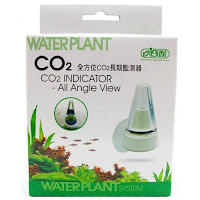
While the Ista uses a simple color chart sticker that is more simple to use, but slightly less accurate (but it still gives us our ballpark numbers we need).
Product Link:
AAP/ISTA CO2 Indicator Test
Please read this article for much more in depth information about planted freshwater aquariums:
“Planted Freshwater Aquarium Care, Information”
 [9] Multi Test Strips; Although not a specific test kit per say, I feel these should be mentioned as I personally use these for convenience for testing my clients aquariums with usually satisfactory results.
[9] Multi Test Strips; Although not a specific test kit per say, I feel these should be mentioned as I personally use these for convenience for testing my clients aquariums with usually satisfactory results.
Although generally not as accurate as liquid test kits and definitely more expensive per test, they more than make up for it in the speed of testing when time is a factor (& also easier for many beginners).
As well, the accuracy of the test strips I have used rivals most common liquid tests despite inaccurate claims to the contrary as long as the strips are kept dry (make sure wet fingers are kept away from the container and that a desiccant is added once opened and you will find that the accuracy will be maintained). The shelf life is not as long on test strips though.
Besides the previous tips as to keeping the strips dry prior to use, make sure to hold the strip perfectly level after dipping, as any running of water after dipping between each test square can result in an inaccurate reading.
What I like best are the API 5 in 1 Test Strips (& similar), while these strips do not have ammonia ammonia test strips, having a nitrites test gives me an accurate idea of any likely ammonia in an established tank (or even an new cycling tank).
Otherwise this test strips kit has all the essential tests I need for my clients established aquariums (which made up more than 95% of my test needs). Only in new tanks do I generally break out the liquid Ammonia test Kit.
Three tests that I consider essential for established freshwater tanks are the KH, Nitrates and GH. (the nitrates to see if my filtration water changes are correct , the KH for pH stability, and finally the very important but unfortunately forgotten GH test for important calcium and other essential electrolytes.
MORE BLUNTLY, I find this test kit vastly more essential than so-called master test kits that lack essential KH & GH tests which for an established aquarium are a MUST from my many years of experience.
Even in marine aquarium this is an excellent kit for quick basic use as the KH is helpful for monitoring critical alkalinity.
 [10] Redox Meter; generally this water parameter will take of itself provided you perform proper aquarium husbandry including: regular water changes with properly ionized water and you maintain a GH level of at absolute minimum of 50 ppm (I find 150+ ppm better for most aquariums/ponds) with regular replenishing of essential mineral ions.
[10] Redox Meter; generally this water parameter will take of itself provided you perform proper aquarium husbandry including: regular water changes with properly ionized water and you maintain a GH level of at absolute minimum of 50 ppm (I find 150+ ppm better for most aquariums/ponds) with regular replenishing of essential mineral ions.
Redox Balance is also maintained by a properly installed UV Sterilizer which has its UV Bulb changed every six months.
Product Links:
*Ultraviolet Aquarium, Pond Sterilizers, Clarifiers
*UV-C Replacement Bulbs, Lamps, Page 1
This is a good parameter to check if you are having unexplained problems and every other test is correct (providing you do not have an unknown disease).
I recommend every aquarist be at least familiar with the Redox Potential, here is an in depth article about aquarium Redox:
“The Redox Potential in Aquariums (& Ponds) and how it relates to proper aquatic health” .
You can use Methylene Blue according to standard dosage to your aquarium water (remove the water for this test), and it stays a brilliant blue, you probably have a positive Redox. If the color dissipates at all (even the slightest) you probably have a reducing number.
This test in no way replaces the accuracy of Redox meter, but it is a simple way to get a handle on your aquariums Redox health.
An ORP (Redox) Meter can be helpful, not in achieving an exact number, but more in testing for normal rhythms of Redox mV. These should change during the day due to lighting, photosynthesis, water changes, use of water conditioners, mineral Cation enhancers such as AAP Wonder Shells, etc.
While the number can vary from 350+mV on the high side to -150mV on the low side, what we want to see is movement based on normal aquarium rhythms and not an aquarium stuck on any one number. As an example, despite some "old timer" an aquarium assumptions, an aquarium stuck at +350mV is likely not a health aquarium.
I have found that balance of both reduction AND oxidation is important, so in a healthy aquarium you should observe different numbers as an indicator of the primary Redox process taking place at the time, such as a reducing Redox immediately following the introduction of water conditioners that remove chlorine, chloramines, etc.
As well, having an accurate Redox reading can then be combined with an accurate pH reading to find the very helpful Aquarium rH number which in turn speaks to aquarium health.
Recommended Product Resources:
*AAP ORP Meter & Temperature Probe
*AAP/Hanna ORP, PH, Temperature Meter #H198121
[11] Silicate Test Kit; Please see the saltwater section for more about these test kits. For FW the primary use is for ongoing Brown diatom algae problems.
For more about Freshwater Aquarium Keeping:
Freshwater Aquarium Care & Information
The list remains similar and I will bypass descriptions that are in common with freshwater test kits.
[1] Ammonia Test Kit; this should be 0 as in FW
[2] KH Test Kit; you do not generally need a GH Test Kit for saltwater (Calcium is what is generally tested although a GH test strip can give you some ball parks ideas as to your Calcium levels which for a fish or FOWLR tank is likely "good enough").
KH (or alkalinity as is called in marine aquariums) should be over 240 ppm (13 dKH)
For an Advanced Marine Alkaline Tester:
AAP/Hanna Marine Alkaline Tester #H1755
Pictured to the right
[3] PH High Range Test Kit; your pH should be between 8.2 - 8.4
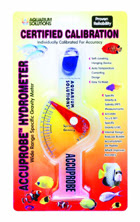
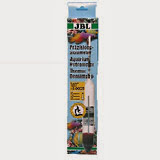
[4] Hydrometer; this instrument tests the specific gravity of aquarium water (in simple terms the amount of salts).
There are two types; the floating glass hydrometers which are more fragile, but also more accurate or the simple floating needle hydrometer that you fill with water.
It is important with both types of hydrometers to clean these with white vinegar (then rinse thoroughly) to prevent hard water buildup which will then cause inaccurate readings.
A related salt measuring device is the Refractometer, which is popular among advanced reef keeping enthusiasts.
My opinion of these based on scientific experiments is that even delicate reef corals can withstand slight variation in salt levels.
In other words I have never found any difference in reef aquariums kept at the highest level of accuracy with a Refractometer over a Hydrometer!
These can be used for making partial or full saltwater dips for freshwater fish.
For Ocean Saltwater the specific gravity should be 1.025, although many keep their "Fish Only" saltwater aquariums between 1.019- 1.024 to help slow parasite infestation and generate slime coat.
I have found some evidence of the later, but no so other than anecdotal observations (including my own) for the prior reason.
For a normal community freshwater aquarium, the specific gravity should be 1.000 to 1.001
For testing small amounts of salt in freshwater, you would need either the larger floating type hydrometer or even a Refractometer, as the popular floating needle type hydrometer generally does not test below 1.012 or 16 ppt in salt levels.
Product Link: Aquarium Hydrometer
[4] Nitrate Test Kit; Nitrates are best under 30-40 for marine fish aquariums and under 20 (even less if possible) for reef aquariums
[5] Marine Calcium Test Kit; this takes the place of the GH Test Kit in freshwater.
Calcium is important to ALL marine life (this includes freshwater too as it is often sadly overlooked), however it is absolutely essential for proper coral growth in marine aquariums.
Your marine Calcium levels should be between 400-450 ppm
Bio-availability is also essential, AAP/SeaChem Reef Advantage Calcium is among the most bio-available calcium supplements available for marine aquariums as it contains ionically balanced Calcium Chloride, Magnesium Chloride, Strontium.
The other top notch alternative is the Balling Method of bio available Calcium supplementation & chemistry maintenance for reef aquariums.
Either method, for long term best results, be wary of the use of popular Calcium Chloride Dehydrate products only or along with economy Soda Ash Sodium Carbonate products peddled by popular discount bulk suppliers can result in a slow build up of sodium chloride even with a stable specific gravity or salinity, resulting in less than optimal ionic balance for your reef aquarium.
Reference: Reef Aquarium Chemistry Maintenance

SeaChem Reef Advantage Calcium
SeaChem Reef Advantage Calcium
For an Advanced Calcium Tester:
AAP/Hanna Calcium Tester #H1758
Pictured to the right
[6] Nitrite Test Kit this should be 0 as in FW
[7] Dissolved Oxygen Test Kit; This kit although not essential is very useful, especially when you suspect over crowding or problems seem to reoccur.
Saltwater (depending on salinity) holds roughly 42% less oxygen than freshwater. Warm water is much less capable of holding oxygen gas in solution than cool water. For example, water that is 90°F can only hold 7.29 ppm DO at total saturation, whereas water that is 45°F can hold 12.13 ppm DO at total saturation.
A dissolved oxygen level of 5-7 ppm is sufficient, the first signs of stress in fish will show if the DO drops below 4 ppm, fatalities will occur at 2 ppm.
These problems will affect Dissolved oxygen (Freshwater or Saltwater):
*No or too little water agitation (via the surface)
*An overstocked tank, which results in larger amounts of waste (bio load) created that in return requires more bacteria to oxygenate the waste.
*Over feeding
*Waste rotting in the filter or in the gravel (common under rocks, in Wet-Dry and Canister filters)
*Green and cloudy water.
This said as for too low of dissolved oxygen, it is possible to have too high of dissolved oxygen as well (although much less likely), this is called oxygen intoxication. Signs of too high DO are usually simple to see on larger fish; for instance, air bubbles seem to come out of the scales. Your aquarium dissolved oxygen level should not be higher than 10 ppm
[8] Magnesium Test Kit; Magnesium is an essential part of chlorophyll, which is necessary for photosynthesis, plants, including algae and the corals. Maintaining a correct magnesium concentration is very important, and is indirectly responsible for fast coral and calcareous algae growth by virtue of making the maintenance of correct calcium and alkalinity figures possible. Magnesium is depleted by algae and by the use of excessive Kalkwasser.
Magnesium is what binds Calcium Carbonate in solution, if levels are low useable calcium levels will also drop. Poor choices of Marine Buffers can further exasperate this problem, this why I STRONGLY recommend a Marine Buffer for adjusting alkalinity in marine aquariums (and EVEN freshwater aquariums) as this product has Magnesium, Calcium, and sodium bicarbonate in the proper ratios.
Magnesium levels in marine aquariums should be between 1200 and 1400 ppm.
Recommended Product Link: AAP/SeaChem Marine Buffer
 [9] Iodine Test Kit; This test kit is semi-important for reef aquaria, more so for corals, both soft and hard, although primarily softies in my experience.
[9] Iodine Test Kit; This test kit is semi-important for reef aquaria, more so for corals, both soft and hard, although primarily softies in my experience.
Iodine is present in natural sea water in a very low concentration (0.06 to 0.08 mg/L) and this iodine occurs as several different species including iodide, iodate, molecular iodine and hypoiodite.
Natural sea/saltwater contains predominantly iodate and to a slight extent iodide.
What is also noteworthy is that many if not most iodine test kits are not capable in detecting iodate. Since in an aquarium iodide can be transferred to iodate. This means that if a test kit is used not capable in detecting iodate, a false low total iodine concentration (sum of iodate and iodide) will be obtained and the iodate concentration can climb far too high and possibly upsetting the aquarium environment.
It should also be noted that time released iodine supplements or supplements containing organically bound/complexed iodine species will give false results with many iodine test kits
This is why I suggest the Salifert Iodine Test Kit, as the Salifert Iodine Profi Test Kit measures all naturally occurring iodine species such as iodate, iodide, molecular iodine and hypoiodite.
Recommended Product Resource: Salifert Iodine Profi Test Kit
It is noteworthy that I have found that in many of my reef aquariums the need for an Iodine Test Kit is not necessary. Generally in my aquarium maintenance route I found adding a set amount of iodine worked just fine (generally about 1/2 to a full dose as per SeaChem's Reef Iodide supplement).
Only when I found some other parameters off and/or a coral (primarily softies) were doing sub par I would then bring out my iodine test kit and even then this parameter often would test OK.
Recommended Product Link for supplemental iodine: SeaChem Reef Iodide
[10] Strontium Test Kit; This test kit is important in accelerating the growth of coral and calcareous algae. Natural sea water contains approx. 7 - 9 mg/L strontium. Strontium is very difficult to test for, but if there is found to be a depletion of calcium in the aquarium then strontium levels are likely to be very low as well. Strontium concentration should be kept between 5 and 20 mg/L.
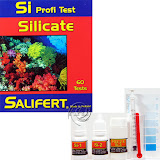 [11] Silicate Test Kit; Although listed in the saltwater section, this test kit can also be useful for testing silicates in freshwater as well, especially where Brown Diatom Algae is a continuing problem. Most silicate test kits are designed to test for silicates down to .2 ppm (mg/L).
[11] Silicate Test Kit; Although listed in the saltwater section, this test kit can also be useful for testing silicates in freshwater as well, especially where Brown Diatom Algae is a continuing problem. Most silicate test kits are designed to test for silicates down to .2 ppm (mg/L).
Natural seawaters contain silicates around 10 ppm however due to differences in a closed system (which an aquarium is) and the ocean it is best to maintain silicates under 1 ppm in an aquarium to prevent diatom blooms and aid in uptake of essential elements such as Strontium by corals.
In freshwater, silicates are generally between 4-20 ppm and should be kept under 4 ppm in an aquarium, although usually this is not a problem in healthy established freshwater aquariums where lighting is good to encourage plants or green algae (both of which will starve also consume silicates limiting diatom growth)
Product Link: SALIFERT SILICATE TEST KIT
[12] Redox Meter; as in freshwater, balance is most important, except Redox is more important consideration in marine aquariums.
Achieving a Redox of about +300 to -100 mV for marine or +125 to -200 mV for freshwater are the raw numbers we are aiming for, however if you have read the article "Aquarium Redox" thoroughly including the outside links/website, you will know that this is an extreme over simplification as there are times for higher and lower Redox readings
[13] Phosphate Test Kit; as in freshwater this should near 0. High phosphate levels in marine aquariums can play havoc with the health and growth of live coral (Phosphates can block the absorption of important minerals).
For more about marine/saltwater aquarium keeping, please read this article: Marine/Saltwater Aquarium Keeping Basics & Information
See this web site for many downloadable test kit directions:
Directions, Color Charts Downloads
Other Recommended Reference Sites

Aquarium Information and Resources (Pond too)
Both basic and in depth articles

Aquarium UV Sterilization; Complete Level One UVC Sterilizer Use Information
*Aquarium Planaria & Detritus Worms

Aquarium Lighting
The most in depth and regularly updated article available FREE on the Internet!
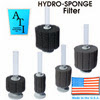
Sponge Filters by American Aquarium
The Premium AAP/ATI Hydro Sponge Filter, from the only online seller with professional use dating back to 1978 (prior to the Internet)

Economy Submersible Aquarium, Fountain Pumps; SunSun JP-033
A better, UPDATED version of the Via Aqua 302 with SUPERIOR Performance, unlike other pumps sold elsewhere as a replacement
ADVERTISEMENT
Labels: ammonia test, Aquarium Test Kit, GH, Hanna Testers, KH, multi strips, pH, Pond Test Kit, reef calcium, titration
SEXING FISH, Stimulating Fish Breeding Behavior
SEXING FISH; The differences between males and females (if any).
By Carl Strohmeyer-PAMR 40+ years experience
Updated 1/22/19
I would also like to point out that although some articles here at Aquarium Answers are intended to be more in depth, THIS ARTICLE is intended to just cover the BASICS and advanced aquarists will need to seek further information elsewhere.
I provide several links to other sites and articles for more expanded information, please check them out as well.
Although information about the breeding of fish is not the main intention of this article, I will provide a few basic factors to consider for many fish developing into a breeding condition (where by "sexing" of the fish is more likely to be successful too).
ADVERTISEMENT
Important Fish Breeding "Stimulants";
- Water temperature; Often changes in temperature can be one water parameter to stimulate fish breeding. How much of a change is often dependent on individual species.
- Water Chemistry; A change in pH, GH, and/or GH is a common aspect of breeding behavior stimulation, especially for fish that live in very monsoonal (seasonal) waters where floods and dry seasons are cyclical.
A Complete Understanding of aquarium chemistry:
Aquarium Water Chemistry - Nutrition; A change in diet, sometimes with more fats and proteins can be an important stimulant for Fish Breeding behavior.
For more about proper fish nutrition:
Quality Fish Food; What ingredients are needed for proper fish nutrition, growth and health). - Storms; although a less known aspect of breeding behavior, it has been shown in studies that many freshwater fish along with the onset of storms that change water chemistry (improving Redox as well), these storms provide lightning storms that further stimulate breeding behavior.
With the use of High End LED Aquarium Lights such as the (TMC GroBeam for Freshwater Aquariums) and the use of a Storm Feature and Multi Power Controller, an aquarium keeper can simulate lightning storms via an internal program that will last 30 minutes
High End LED Resource:
*LED Aquarium Lights
*TMC GroBeam 600
*TMC Storm Feature and Multi Power Controller
Important Fish Breeding "Water Condition Basics";
Simply put, maintaining good water conditions is a must, this includes 0 ammonia or nitrites, low nitrates, a stable pH, at least some positive mineral electrolytes (some fish need more than others for positive breeding conditioning).
Often successful breeding is performed in bare, no substrate aquarium; this in part aids in the ability to vacuum and wastes as soon as it falls and limits the possibility of devastating Saprolegnia outbreaks in fish or eggs.
Another key point is while many breeding fish prefer at least some quiet calm areas to breed or rest, at least SOME filtration MUST be present. I base this on the FACT most breeders as well as my breeding of fish have been in tanks with some sort of filtration. Generally speaking, an air driven Sponge Filter is your best choice for this.
A Resource for:
Aquarium Sponge Filters
See Also:
*Aquarium Nitrogen Cycle
*Aquarium Chemistry; The Importance of Maintaining Positive Calcium Ion levels
*Freshwater Aquarium Care
HERE ARE A FEW BASICS OF SEXING FISH:
Livebearers: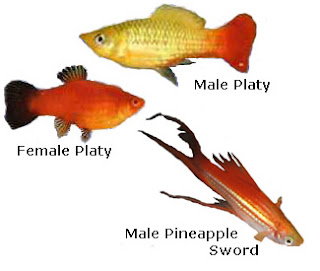
In Livebearers such as platys the male has a short tube called gonopodium in place of the anal fin, while the female has a normal triangular anal fin.
Guppies more transparent bodies (although many other light colored livebearers are similar here) are easier than many livebearers to see fry development inside the female.
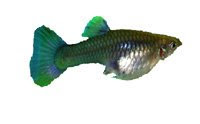 Signs that your guppy or other livebearer is about to give birth include a large belly, a box like look from the front view, and a darker gravid spot which is under the pregnant females tail, which many identify as a stained glass window where the fry come out.
Signs that your guppy or other livebearer is about to give birth include a large belly, a box like look from the front view, and a darker gravid spot which is under the pregnant females tail, which many identify as a stained glass window where the fry come out.
As the babies near birth you can sometimes see eyes of the unborn fry as tiny black dots.
Click picture of guppy to enlarge
The gestation period in livebearers, which the interval between fertilization and live birth can vary, however as a generalization this time period is about 4-6 weeks at 78 F. The size of the brood can also vary greatly.
Most livebearers prefer water higher in mineral ion content and although salt is not required by most livebearers, it can be helpful as well.
Keep optimum conditions including proper mineralization as well as supplementing their diets with frozen/live/FD foods along with quality flake, crumbles, & conditioning foods (I would strongly suggest foods high in spirulina such as Spirulina 20 as well as ultra premium staple diets such as "Clay Neighbor's AAP All Natural" Premium Optimized Custom Fish Food Crumbles).
More information about salt use:
Aquarium Answers, Salt in Freshwater Aquariums
As for the fry, I have achieved phenomenal success by simply powdering Spirulina Flakes at the time of most of my livebearer breeding, of which I had several tanks of Platties alone. I was using Green Flake Plus which is currently not available, but similar products such as Spirulina 20 still are. I also would supplement them with frozen baby brine shrimp or microworms.

Fish food Resources:
*Spirulina 20 Fish Food Flake
*Freeze Dried Fish foods; Worms, Brine Shrimp
*"Clay Neighbor's AAP All Natural" Premium Optimized Custom Fish Food Crumbles
Most livebearers of both sexes will eat their young so separation of all other fish is best and the use of a heavily planted aquarium (live or fake) or breeder trap for the female is advised.
Both swords and platties are capable of cross breeding as are Mollies and Guppies.
For further information please read my article about the care of Mollies (of which the care for other livebearers is similar):
Aquarium Answers: Keeping Mollies in an Aquariums
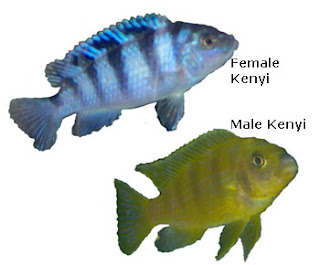 In Cichlids some species, males and females are readily distinguishable by color, size or shape.
In Cichlids some species, males and females are readily distinguishable by color, size or shape.
For others it is difficult or even impossible to tell the sexes apart in non breeding individuals.
Here are a few specific methods to sex certain Cichlids:
- Body shape: The male form a pair of cichlids in the wild is generally larger than female. Some females are larger than some males especially if not found in a breeding pair, so size alone is not a reliable indicator. Males may have a hump on the forehead. The size and shape of this hump differs by among species. This again is not foolproof as females in aquariums have also grown humps, so the presence of a hump does not in itself identify a male. Females may also rounder.
- Fin length: Males Cichlids will often have longer, more flowing and pointed anal and dorsal fins. This method has many exceptions too (such as female Convict Cichlids).
- Coloration: This is a species specific check for the sex of the fish.
A Few Examples:
- Female convict cichlids have orange on the belly, particularly when they are ready to breed, while males lack the orange.
- In Auratus African cichlids from Lake Malawi, the young fish have female coloring of a yellow-golden base with three black bands, aligned with white stripes running parallel to these black bands. As the fish mature the males reverse to a black base body color with yellow or turquoise bands.
- In Kenyi African cichlids from Lake Malawi, the male and female start as basically a “blue” fish with stripes (there are subtle differences) and the male develops a more yellow golden background color while the female remains blue (see photo above left courtesy Eve).
- In Yellow Labidochromis African Cichlids (also from Lake Malawi) the male will often have a darker black border on the edge of there Dorsal fin, while the female is much less noticeable. Also the male Lab. May have an “egg spot” (or dummy spot) on his anal fin (please see the photo to the left, also courtesy Eve)
- Breeding Tube (Papilla): This is the only accurate way to sex angelfish and even this method is not always easy and can only be performed on mature angelfish.
In the female angelfish the breeding tube is kind of stubby while in the male the breeding tube is more pin like (& difficult to see IMO).

Here is a tip as to determining Mbuna African Cichlids from Jon V. (from "Everything Aquatic"):
"When you get a group of fry or brood, keeping them in their own grow out tank for about a month. During this time as you feed fry foods, watch the group to see who's getting the most of the foods. Even at that early age, I've seen a tendency which I think is noted in other forums, that males will even be aggressive for food as early as the first few days when released. After about one month of this, you can take a brood of say about 20, and the ones that have already grown out larger then the others, you have about a 75-80% chance, those are males. While I've seen on some occasions, females grow rather large early on, I find this has great accuracy when comparing the first and second months of age."
Reference:
www.everything-aquatic.com/
See this article from Jon V from Everything Aquatic:
Venting cichlids to determine sex
For more about sexing cichlids (from Ron Coleman’s Cichlid Research Site):
Cichlid Research- Sexing Cichlids
Goldfish:
Sexing Goldfish is very difficult before they reach sexual maturity.
One way to tell is by looking at the shape of the vent. Females may have rounder convex vents while males have thinner concave vents.
The pectoral fins of males may be rather thick and stiff (compared to those of female goldfish) and with a more pronounced outer ray.
Another way to tell is by male goldfish will developing breeding stars on their gill covers and along the first ray of their pectoral fins when they are ready to breed.
For more about sexing goldfish:
“Goldfish Basics”
Bettas;
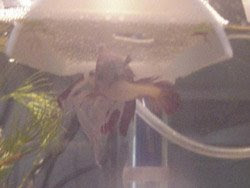 Male Bettas in the wild are short finned, so fins are not as reliable a way to tell the sex in bettas and is common belief.
Male Bettas in the wild are short finned, so fins are not as reliable a way to tell the sex in bettas and is common belief.
Here are a few ways to improve the accuracy of sexing your betta:
- While looking at the male betta head on, there is an extra flap of skin under his body. The extra skin is an extended flap of skin from the gills.
- Again look head on, the males will have a much bolder head and fin structure.
- While a little less accurate, a male will generally not have a white dot under his body, in between his ventricles. Females will have this white dot.
Taken together you can give a much more accurate assessment of your Bettas sex.
See this article for more about Betta Habitat of which this knowledge may help in stimulating Betta Breeding behavior:
Betta Wild Habitat
Gouramis;
Cousins to the Betta, in which both have a labryinth organ, which allows them to breath air directly. Both also come from SE Asia.
Many Males can be differentiated from females by the shape of the dorsal fin, which is long and pointed in males, compared to the females' shorter and more rounded dorsal fin.
Females that are prepared for spawning will show a pronounced swelling in the breast area, while the male will be more slender in the breast area.
In many Dwarf Gouramis, the males are much more colorful than the females (this is not usually true from my experience with other Gouramis such as blues).
Please note that these are generalizations and do not apply to all Gouramis.
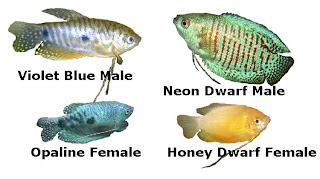
Currently I have not found any in depth articles about Gouramis (other than species specific) that I can recommend.
Either I will write one at some point in the future (as I did for mollies) or if one is brought to my attention, I will post it.
Other Recommended Reference Sites

Aquarium and Pond Information -A useful source for current

Aquarium Lighting; Basic to Advanced
*Filtration Aquarium Filter Help, Troubleshooting, Reviews
*
UV Sterilization for Aquarium or Pond
A MUST READ article for anyone looking to move up from basic to more advanced fish keeping!!
*Ick; Ichthyophthirius Multifilis, Treatment, Identification, and Life Cycle
 FISH AS PETS
FISH AS PETS
Fish as Pets with articles & commentary of Interest to the Aquarium Hobby
Including articles such as this one:
Melafix Dangers; Effect of Water Parameters on Melafix when used for Bettas, Labyrinth Fish
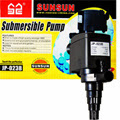 SunSun JP-023 Aquarium Power Head Water Pumps
SunSun JP-023 Aquarium Power Head Water Pumps
Superior performance and value when compared to many more well known brands such as Hagen or Marineland

TMC Premium Fluidized Sand Bed Filters
Premium, second to NONE Aquarium Bio Filters, that with optional Oolitic Sand also maintain essential marine aquarium calcium levels, alkalinity, & electrolytes that are important to ALL Marine life, Goldfish, African Cichlids, Livebearers & more
ADVERTISEMENT
Labels: Breed Fish, Female Fish, Fish Breeding, Fish Sex, Male Fish, Sexing Fish, Stimulate Breeding















